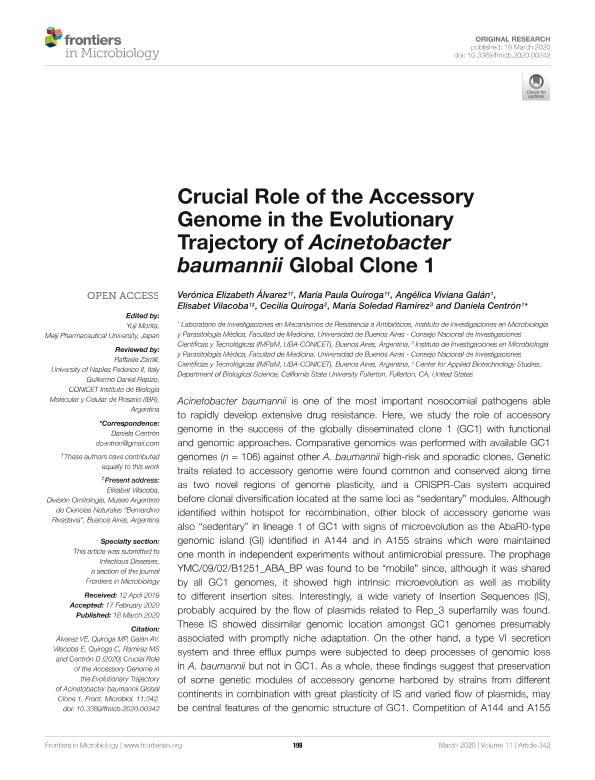Capítulo de Libro
Crucial Role of the Accessory Genome in the Evolutionary Trajectory of Acinetobacter baumannii Global Clone 1
Título del libro: Unraveling the Biology, Genetics, and Host/Environmental Interactions of Acinetobacter
Alvarez, Verónica Elizabeth ; Quiroga, María Paula
; Quiroga, María Paula ; Galán, Angélica Viviana; Vilacoba, Elizabeth; Quiroga, Cecilia
; Galán, Angélica Viviana; Vilacoba, Elizabeth; Quiroga, Cecilia ; Ramirez, Maria Soledad; Centron, Daniela
; Ramirez, Maria Soledad; Centron, Daniela
 ; Quiroga, María Paula
; Quiroga, María Paula ; Galán, Angélica Viviana; Vilacoba, Elizabeth; Quiroga, Cecilia
; Galán, Angélica Viviana; Vilacoba, Elizabeth; Quiroga, Cecilia ; Ramirez, Maria Soledad; Centron, Daniela
; Ramirez, Maria Soledad; Centron, Daniela
Fecha de publicación:
2020
Editorial:
Frontiers Media S.A.
ISBN:
9782889639465
Idioma:
Inglés
Clasificación temática:
Resumen
Despite not being a disease in and of itself, antibiotic resistance could be consideredthe global epidemic of modern times, since it produces the failure to prevent andtreat many infectious diseases. This can ultimately lead to untreatable microbialinfections becoming more widespread and this will significantly increase morbidityand mortality. This worldwide problem is estimated to cause millions of deathsper year and could become an even more significant menace to humanity thanestablished illnesses, such as cancer.In February 2017, the World Health Organization (WHO) published a list ofantibiotic-resistant priority pathogens a catalogue of 12 families of bacteria whichpose the greatest threat to human health - and Acinetobacter baumannii is leadingthe list. The most critical group includes multidrug-resistant bacteria, which pose aparticular threat in hospitals, nursing homes, and among patients whose care requiresdevices such as ventilators and blood catheters. This group includes Acinetobacter,Pseudomonas, and various Enterobacteriaceae and they are often associated withdeadly infections, such as bloodstream infections and pneumonia. Furthermore,these bacteria have become resistant to a large number of antibiotics, includingcarbapenems and third generation cephalosporins ? the best available antibioticsfor treating multidrug-resistant bacteria.A. baumannii is a particularly worrisome example and demands attention: Thispathogen turned into a menace to humans during the late 70s, likely as a result ofintense antibiotic use in hospital settings, and became one of the microorganismsthat are challenging the antibiotic era. Its extreme genome plasticity, combined withmechanisms of horizontal genetic transfer, have played a key role in the evolutionof this microorganism, as well as its adaptability to unfavorable environments.However, its pathophysiology, as well as the mechanisms leading to its success asa pathogen, are not that simple to unveil. However, what is clear is that the triad ofhost-pathogen-environment is crucial in selection and establishment ofmultidrug-resistant clones and outbreaks.Indeed, there are still many aspects of this pathogen that require a deeperunderstanding - not only regarding mechanisms of resistance but also itsglobal pathophysiology. For example, basic understanding of transmissionmechanisms; knowledge of external factors modulating persistence of thepathogen; genetic effects on host susceptibility and infectiousness; mechanisms ofpathogenicity and their dynamics; and genetic variation of the pathogen affectingvirulence and transmissibility are some aspects that would require further study.Frontiers in Microbiology 3 August 2020 | Unraveling the Biology, GeneticsFurthermore, the importance of other members of the genus as important nosocomialpathogens, such as Acinetobacter nosocomialis, has been increasingly recognizedduring the last few years.
Palabras clave:
BIOLOGY
,
GENETICS,
,
HOST/ENVIRONMENTAL INTERACTIONS
,
ACINETOBACTER
Archivos asociados
Licencia
Identificadores
Colecciones
Capítulos de libros(IMPAM)
Capítulos de libros de INSTITUTO DE INVESTIGACIONES EN MICROBIOLOGIA Y PARASITOLOGIA MEDICA
Capítulos de libros de INSTITUTO DE INVESTIGACIONES EN MICROBIOLOGIA Y PARASITOLOGIA MEDICA
Citación
Alvarez, Verónica Elizabeth; Quiroga, María Paula; Galán, Angélica Viviana; Vilacoba, Elizabeth; Quiroga, Cecilia; et al.; Crucial Role of the Accessory Genome in the Evolutionary Trajectory of Acinetobacter baumannii Global Clone 1; Frontiers Media S.A.; 2020; 1-220
Compartir



